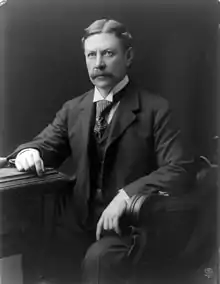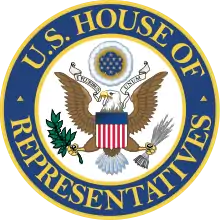William Henry Moody
William Henry Moody (December 23, 1853 – July 2, 1917) was an American politician and jurist who held positions in all three branches of the Government of the United States.
William Moody | |
|---|---|
 | |
| Associate Justice of the Supreme Court of the United States | |
| In office December 12, 1906 – November 20, 1910[1] | |
| Nominated by | Theodore Roosevelt |
| Preceded by | Henry Brown |
| Succeeded by | Joseph Lamar |
| 45th United States Attorney General | |
| In office July 1, 1904 – December 12, 1906 | |
| President | Theodore Roosevelt |
| Preceded by | Philander Knox |
| Succeeded by | Charles Bonaparte |
| 35th United States Secretary of the Navy | |
| In office May 1, 1902 – June 30, 1904 | |
| President | Theodore Roosevelt |
| Preceded by | John Davis Long |
| Succeeded by | Paul Morton |
| Member of the U.S. House of Representatives from Massachusetts's 6th district | |
| In office November 5, 1895 – May 1, 1902 | |
| Preceded by | William Cogswell |
| Succeeded by | Augustus Peabody Gardner |
| Personal details | |
| Born | William Henry Moody December 23, 1853 Newbury, Massachusetts, U.S. |
| Died | July 2, 1917 (aged 63) Haverhill, Massachusetts, U.S. |
| Political party | Republican |
| Education | Harvard University (BA) |
| Signature | |
Early life
Moody was born in Newbury, Massachusetts, the son of Henry Lord Moody and Melissa Augusta (Emerson) Moody. His father owned and managed several farms, and Moody attended the local schools of Newbury, Salem, and Danvers. He graduated from Phillips Academy in 1872 and Harvard University, Phi Beta Kappa in 1876.[2] After four months attending Harvard Law School, he began to study law in the office of Richard Henry Dana, Jr., and attained admission to the Massachusetts bar in 1878.
Start of career
Early in his legal career, Moody first was elected city solicitor of Haverhill, Massachusetts in 1888. After appointment as the District Attorney for Eastern Massachusetts in 1890, he gained widespread notoriety in 1893 as the junior prosecutor in the Lizzie Borden murder case. While his efforts were unsuccessful he was generally acknowledged as the most competent and effective of the attorneys on either side.
U.S. Congress
He was elected to the U.S. House of Representatives from Massachusetts, and served from 1895 until 1902. He served on the powerful Appropriations Committee, and also held seats on Insular Affairs, Expenditures in the Department of Justice, and the Joint Commission on the Transportation of the Mails. He was a candidate to succeed Thomas B. Reed as Speaker in 1899, but the post was won by David B. Henderson.
Secretary of the Navy
During President Theodore Roosevelt's administration, Moody served as the Secretary of Navy from 1902 to 1904. He oversaw the start of the Roosevelt-era expansion of the Navy, including an increase in the number of ships, as well as an effort to increase manpower by improving efforts to recruit sailors from non-coastal states. Moody also negotiated with the government of Cuba for the original lease that permitted construction and occupation of the Guantanamo Bay Naval Base.
U.S. Attorney General
Moody served as Attorney General from 1904 to 1906. In this post, Moody actively followed Roosevelt's trust-busting policies, negotiating with 'good' trusts like U.S. Steel but prosecuting 'bad' ones like Standard Oil. After failing to convince William Howard Taft to take the seat, on December 3, 1906, Roosevelt nominated Moody as an Associate Justice of the U.S. Supreme Court and Moody was confirmed on December 12, 1906. He took his seat on the Court on December 16, 1906.[3][4]
U.S. Supreme Court
Moody's service on the Court was brief but eventful, and he authored 67 opinions and five dissents. His most noted opinion was in the minority in Employers Liability Cases (1908), where he held that Congress' power to regulate interstate commerce included the ability to legislate management's relationship with employees. While he generally supported enhanced federal powers, opinions as Twining v. New Jersey (1908), where he held that the Fifth Amendment's protection against compulsory self-incrimination did not apply to cases presented in state courts, made him hard to pigeonhole. He also wrote for a unanimous court in the famous case of Louisville & Nashville Railroad Co. v. Mottley, which limited federal question jurisdiction to cases in which the plaintiff's cause of action was based on federal law.
By 1908, Moody suffered severe rheumatism. This affected Moody to such an extent that his last sitting on the bench was May 7, 1909, when he left for a brief rest and never returned. With the age- and health-enfeebled Supreme Court of 1909 crippled (President William Howard Taft was to make a record-setting five appointments due to death and resignations over a course of a single year in 1910–1911), Taft urged Moody, then the youngest justice at 55, to step down. After Taft successfully lobbied Congress for a Special Act to grant Moody retirement benefits not normally granted unless justices reached age 70 or 10 years of service (enacted June 23, 1910), Moody retired from the Court on November 20, 1910.[5]
Death and burial
Moody was not married, and had no children. He died in Haverhill, Massachusetts on July 2, 1917, and was buried at Byfield Cemetery in Georgetown, Massachusetts.
Awards and honors
In 1904, Moody received the honorary degree of LL.D. from Tufts University and Amherst College.
Legacy
After Moody's death, some of his official papers were placed in the custody of Professor Felix Frankfurter, then of Harvard Law School. They are now in the collection of Frankfurter's papers in the Manuscript Division of the Library of Congress. Moody's office furnishings and papers were donated to the Haverhill Historical Society and there is a Moody Room open to the public at the Buttonwoods Museum in Haverhill that features his personal collection.[6]
USS Moody (DD-277) was named for him.
In 2018, television and film actor Jay Huguley portrayed Moody in Lizzie, a biographical thriller film about Lizzie Borden.
See also
- List of Justices of the United States Supreme Court
Notes
- "Federal Judicial Center: William Henry Moody". December 11, 2009. Archived from the original on May 13, 2009. Retrieved December 11, 2009.
- Supreme Court Justices Who Are Phi Beta Kappa Members, Phi Beta Kappa website, accessed Oct 4, 2009
- HarpWeek: Cartoon of the Day at harpweek.com
- "Biographical Directory of the United States Congress". Biographical Directory of the United States Congress. Retrieved September 11, 2018.
- The Supreme Court Historical Society Archived 2005-09-03 at the Wayback Machine at supremecourthistory.org
- William H. Moody Buttonwoods Museum
References
- Lewis L. Gould. "Moody, William Henry"; American National Biography Online February 2000.
- James F. Watts, Jr., "William Moody," in The Justices of the United States Supreme Court 1789–1969, ed. Leon Friedman and Fred L. Israel (1969),
Sources and external links
- United States Congress. "William Henry Moody (id: M000883)". Biographical Directory of the United States Congress.
 This article incorporates public domain material from the Biographical Directory of the United States Congress website http://bioguide.congress.gov.
This article incorporates public domain material from the Biographical Directory of the United States Congress website http://bioguide.congress.gov.- This article incorporates text from the public domain Dictionary of American Naval Fighting Ships.
| U.S. House of Representatives | ||
|---|---|---|
| Preceded by William Cogswell |
Member of the U.S. House of Representatives from Massachusetts's 6th congressional district 1895–1902 |
Succeeded by Augustus Gardner |
| Political offices | ||
| Preceded by John Long |
United States Secretary of the Navy 1902–1904 |
Succeeded by Paul Morton |
| Legal offices | ||
| Preceded by Philander Knox |
United States Attorney General 1904–1906 |
Succeeded by Charles Bonaparte |
| Preceded by Henry Brown |
Associate Justice of the Supreme Court of the United States 1906–1910 |
Succeeded by Joseph Lamar |







